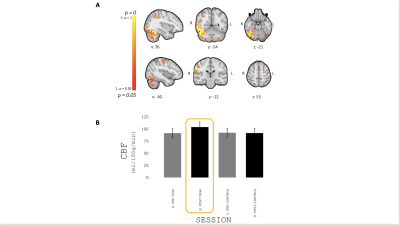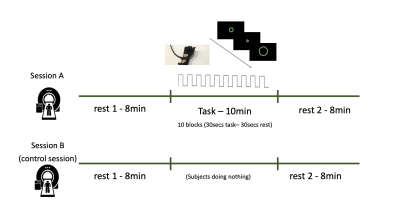Eleonora Patitucci1, Michael Germuska1, James Kolasinski1, Valentina Tomassini1,2,3, and Richard G Wise1,2
1CUBRIC, Cardiff University, Cardiff, United Kingdom, 2Institute for Advanced Biomedical Technologies (ITAB), Department of Neurosciences, Imaging and Clinical Sciences, University of Chieti-Pescara, Chieti, Italy, 3MS Centre, Neurology Unit, SS. Annunziata University Hospital, Chieti, Italy
1CUBRIC, Cardiff University, Cardiff, United Kingdom, 2Institute for Advanced Biomedical Technologies (ITAB), Department of Neurosciences, Imaging and Clinical Sciences, University of Chieti-Pescara, Chieti, Italy, 3MS Centre, Neurology Unit, SS. Annunziata University Hospital, Chieti, Italy
This voxel-wise investigation of cerebral
blood flow shows a sustained increase in resting state perfusion in task
relevant regions after the completion of a 10-minute learning task, demonstrating
changes in resting perfusion with motor learning.

FIG. 4 - (A) Areas showing an increase in resting CBF with
learning reported as p-value. (B)
Mean±SEM resting CBF during the different resting periods (pre-/post-
task/control) in significant voxels. Resting CBF significantly increased
following completion of the task 15.8% on average compared to the pre-task.

FIG. 1 - Participants were scanned twice. During the “task” session (A),
participants underwent 8 minutes of resting state (RS), 10 minutes of motor
task and 8 minutes of RS. During the “control” session (B), participants
underwent 8 minutes of RS, 10 minutes where they were asked to lay still in the
scanner and 8 minutes of RS again. During the rest scans, in the task session
and for the entire duration of the control session, a white fixation cross and
the word “REST” were presented on a black screen.
